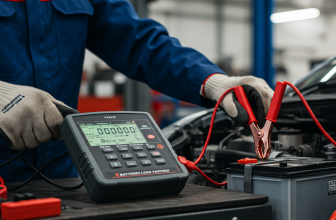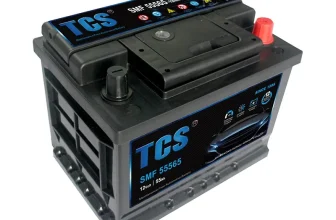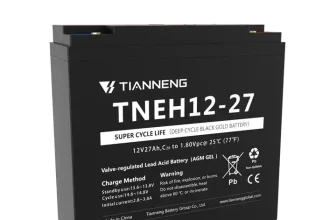Deep cycle batteries, as their name suggests, are designed to be
regularly discharged using most of their capacity. Unlike car batteries,
which only provide short bursts of energy, deep cycle batteries provide
sustained power over a prolonged period. They have thicker plates which
allow for a deeper level of discharge without causing severe damage.
These batteries are recharged after every use, with a typical discharge
of 60% to 70% of their capacity. They are essential in applications
where a consistent and steady supply of power is needed over an extended
period, such as powering electric vehicles, marine applications, and
renewable energy systems.
The significance of
Deep Cycle Batteries
Deep cycle batteries play a crucial role in a range of industries and
applications around the world. Their unique structural design and
incredible power capacity bring them to the heart of renewable energy
storage, mobility aids, sea-faring vehicles, and much more. Unlike
regular batteries that deliver short bursts of energy, deep cycle
batteries are engineered to provide sustained power over a longer
period. These powerhouses don’t just keep gadgets and vehicles running
but are an integral part of systems where energy reliability is
non-negotiable. In a world progressively moving towards autonomy and
electrical energy utilization, the importance of deep cycle batteries
cannot be understated.
The Basics of Deep Cycle
Batteries
How a Deep Cycle Battery
works
A deep cycle battery operates on a basic principle called an
electrochemical reaction, which enables the battery to store and
discharge energy. Inside a deep cycle battery, there are two lead plates
immersed in a solution of sulfuric acid, often referred to as an
electrolyte.
When the battery is in use (discharging), a chemical reaction occurs
that causes the sulfur in the acid to attach to the lead plates,
creating lead sulfate. This reaction generates electricity. During the
recharging process, this reaction is reversed. The sulfate detaches from
the lead plates and returns to the acid, restoring the energy in the
battery.
Unlike regular batteries that provide short bursts of energy, deep
cycle batteries are specially designed to be discharged over a long
period. They have thicker lead plates which enable them to withstand
prolonged discharging and recharging cycles. This slow and steady energy
release is what makes deep cycle batteries ideal for applications that
require a sustained power supply.
Different types of Deep
Cycle Batteries
Deep Cycle Batteries come in a variety of types, each with their
unique properties and applications, suitable for different
circumstances.
The first type is the Flooded Lead-Acid Battery, which is the most
common and cost-effective. They work by using a liquid electrolyte,
consisting of sulfuric acid and distilled water, to initiate a chemical
reaction that provides a flow of electricity.
Gel Cell Batteries follow next. The only difference between these and
their flooded counterparts is that in gel cells, silica dust is added to
the electrolyte—forming a thick putty-like gel. This simple modification
brings two main advantages: the batteries are leak-proof, and they can
operate in any position without affecting performance levels.
The third type, Absorbed Glass Mat (AGM), brings in an entirely
different approach. Here, a fiberglass mat is saturated with the
electrolyte, then squeezed between the battery plates. This results in a
compact and durable design that can produce high power outputs in short
bursts.
Finally, we have the Lithium-ion and Lithium Iron Phosphate
Batteries, which are the newest to the scene. Being more efficient,
durable, and versatile, they offer significantly higher performance
rates compared to the other types but are substantially more
expensive.
Key Features of Deep Cycle
Batteries
Durability and Longevity
Deep Cycle Batteries are renowned for their exceptional durability
and longevity, which significantly set them apart from standard
batteries. These batteries are designed to deliver a consistent amount
of current over an extended period. They are built with thick active
plates and a high-density active paste material, allowing them to
perform under challenging conditions and withstand repeated deep
discharging.
Unlike regular batteries that could fail after significant deep
discharging, deep cycle batteries can manage between 50% to 80%
discharge over and over again, without any major loss in their overall
capacity. This makes them immensely durable, enabling users to rely on
their service for years to come.
The life span of a deep cycle battery largely relies on how it is
used, maintained, and charged. Under optimal usage and maintenance
conditions, deep cycle batteries can last between 4 to 8 years, perhaps
even longer, providing users with the desired value for their
investment. Given this remarkable longevity, these batteries have become
an ideal choice for functions demanding sustainable power supply.
High Energy Capacity
Deep cycle batteries are renowned for their high energy capacity,
setting them apart from many other types of batteries. This is one of
their prominent features that makes them particularly useful and
efficient in numerous applications. Their high energy capacity means
they are capable of providing stable and continuous power output over a
long period.
In contrast to standard batteries which are designed for brief, high
current discharges, deep cycle batteries deliver their capacity over a
much longer time horizon. This quality, combined with their capability
for deeper discharges, allows them to deliver more usable power, making
them the ideal choice for systems that require sustained power
delivery.
Depth of Discharge
The Depth of Discharge (DoD) represents one of the distinguishing
features of deep cycle batteries. Unlike regular batteries, deep cycle
batteries can discharge a significant portion of their energy capacity
without damaging the battery. Their design permits a discharge of up to
80%, though most manufacturers recommend a DoD of 50% for optimal
battery lifespan. This tolerance allows for far more utility and
flexibility in how the energy stored in the battery can be used, thereby
making deep cycle batteries an excellent choice in systems where a
considerable level of power is required over extended periods. However,
it is important to note that deeper discharges can shorten the overall
lifespan of the battery, so users should find the right balance that
suits their needs.
Applications of Deep Cycle
Batteries
Recreational
Vehicles (RV) and Marine Applications
Deep cycle batteries play a pivotal role in powering recreational
vehicles (RVs) and marine applications. In an RV, aside from the engine,
there are various electrical devices that need power – such as lighting,
refrigeration, heating, and the water system. A deep cycle battery is
designed to deliver power over a prolonged period, fulfilling these
needs effectively. Additionally, these batteries can be discharged and
recharged frequently, which makes them ideal for use in an RV that often
goes for days or weeks without being plugged into a stationary power
source.
In marine applications, deep cycle batteries are indispensable, as
they power all onboard electrical systems – from navigation and
communication devices to lighting and other essential equipment. The
ability to withstand constant draining and recharging makes them
extremely reliable, particularly during long voyages. Plus, their high
energy capacity is able to sustain power-hungry equipment over an
extended period, providing the necessary peace of mind when out at sea.
Furthermore, many deep cycle batteries are designed to be spill-proof
and vibration-resistant, adding an additional layer of safety and
durability in marine environments.
Renewable Energy Systems
Deep cycle batteries play a significant role in renewable energy
systems, especially in solar and wind power setups. In these systems,
energy is not always consistently produced – for example, solar panels
only generate electricity during the day, and wind turbines work
optimally when there’s wind.
Deep cycle batteries come into play by storing the power produced
during these peak periods, providing an uninterrupted supply during
times when the system cannot generate enough power. They enable these
systems to operate efficiently and continuously by offering backup
power.
For instance, in a solar power system, the batteries store excess
energy produced during the day. When the sun goes down, and solar panels
stop producing electricity, the system can then draw stored power from
the deep cycle batteries, ensuring consistent energy supply.
Furthermore, their ability to discharge deeply (use a large majority
of their capacity) without significant damage makes them an ideal choice
for renewable energy systems, where fluctuations in energy availability
can be drastic. They operate effectively in systems that require regular
and complete discharging, recharging, and prolonged power output. This
makes them a vital component in the sustainable future of energy.
Electric Wheelchairs
and Mobility Scooters
Deep cycle batteries play a crucial role in powering electric
wheelchairs and mobility scooters providing autonomy and convenience to
users with varying mobility challenges. These devices require a reliable
and continuous supply of power for optimal performance, a demand met
efficiently by deep cycle batteries.
These batteries offer a higher depth of discharge allowing the
wheelchairs and scooters to run for longer periods before needing a
recharge. Their durable design is perfect for the heavy-duty usage often
linked with mobility tools. The repeated charge and discharge cycles
experienced by these devices would seriously damage other types of
batteries, but deep-cycle batteries thrive under this usage pattern.
Furthermore, the absence of ‘memory effect’ in these batteries
ensures that they don’t have to be completely drained before recharging.
This characteristic translates to a greater convenience for the users,
allowing them to recharge their mobility scooters or wheelchairs after
each use without worrying about a reduction in their battery
lifespan.
In essence, the effective use of electric wheelchairs and mobility
scooters hinges significantly on the impressive capacity and durability
of deep cycle batteries. Their ability to provide consistent power after
numerous cycles of heavy discharge and recharge makes them an integral
feature of these mobility devices.
Maintenance and
Care of Deep Cycle Batteries
Regular Charging and
Discharging Process
Maintaining the efficiency of deep cycle batteries heavily relies on
a proper and regular charging and discharging regimen. Unlike regular
batteries, which offers a burst of power for a short duration, a deep
cycle battery is designed to produce a steady amount of current over a
long period. Thus, it’s critical to understand the significance of a
regular charging routine.
The batteries should not be completely drained before charging since
deep discharge can significantly affect the battery’s lifespan.
Nevertheless, they are designed to handle deeper discharge cycles. As a
general guideline, try to avoid letting the battery discharge below 50%
capacity before initiating a recharge. This approach ensures the battery
has a balance between its depth of discharge and the load demand, thus
enhancing its longevity.
It’s worth noting that inadequate charging or overcharging can cause
significant harm to any deep cycle battery. Hence, it’s important to use
a smart charger that intelligently adapts the input power depending on
the battery’s state of charge. A regular charging routine helps increase
the lifespan and efficacy of deep cycle batteries, facilitating their
use in the longer term.
Of course, the charging and discharging patterns primarily depend on
the battery technology (like lead-acid or lithium-ion), the specific
application, and the manufacturer’s specific guidelines. Detailed
information is usually supplied by manufacturers on the best charging
and discharging practices for their battery models.
Use of Quality Chargers
Just like any other battery, deep cycle batteries thrive on good
quality charging. Using a quality charger is a crucial part of
maintaining deep cycle batteries. It’s important to understand that not
all chargers are created equal and the right type can significantly
prolong the lifespan of your battery.
High-grade chargers often have multi-stage charging capabilities,
which is an optimal method for charging deep-cycle batteries. This
process entails an initial higher voltage bulk charging, followed by a
lower voltage absorption charging and finally a float stage that
maintains the battery at a safe level to prevent overcharging.
Another reason a quality charger is key for deep cycle batteries is
that they usually get drained more than regular ones. Consequently, they
require a charger that can fully restore the energy they’ve expended,
which can only be guaranteed by a proven, reliable charger.
Most importantly, a worthy charger is one that is appropriate for the
specific type of deep cycle battery you have, be it flooded, gel or AGM.
Using a charger incompatible with your battery can result in battery
damage or decreased lifespan. So always make sure to select a charger
that matches your battery’s specific needs.
Furthermore, a good quality charger will provide protection features
like overcharging prevention, short circuit protection, and even
temperature compensation, ensuring safer and more efficient charging.
These considerations all speak to the value of investing in quality
chargers when it comes to taking care of deep cycle batteries.
Best Practices for
Extending Battery Life
Ensuring the longevity of your deep cycle batteries is a matter of
diligent care and adherence to a few best practices. First and foremost,
keeping the battery fully charged whenever possible enhances the
battery’s lifespan. Batteries that are left discharged for extended
periods of time can suffer permanent damage.
Temperature regulation is another key aspect to consider. Batteries
are best used and stored in cool and dry locations. Extreme
temperatures, whether hot or cold, can cause severe damage to your
battery’s lifespan and overall functionality.
In addition, make sure you only use high-quality, compatible chargers
to charge your batteries as incompatible chargers can lead to under or
overcharging, thereby reducing efficacy and lifespan. Furthermore,
equalization, which is the controlled overcharging of the battery, is
another method to extend the battery life. This process helps in
rebalancing the cells and preventing sulfation.
A regular check on your battery’s electrolyte levels can save it from
probable internal damage – the electrolyte levels need to be maintained
and topped off with distilled water only. Moreover, regular cleaning of
the battery terminals from corrosion buildup can also help in
maintaining optimal performance.
Lastly, try to avoid full discharges and overcharging as both can
significantly degrade the battery life. Instead, make it a habit to keep
the discharge within the recommended Depth of Discharge (DoD) levels of
the manufacturer.
By adhering to these best practices, you can easily garner maximum
performance out of your deep cycle batteries for an extended period.
Pros and Cons of Deep
Cycle Batteries
Advantages of Deep Cycle
Batteries
Deep cycle batteries provide several advantages that make them a
go-to choice for many power-intensive applications. First and foremost,
their most significant advantage is their ability to provide a steady
amount of power over a long period. This differentiates them from other
batteries which can only offer bursts of energy.
Secondly, they have a high depth of discharge, meaning they can be
heavily discharged and utilized to their maximum capacity without
negatively affecting their lifespan. This contrasts with other batteries
which often lose their effectiveness after being substantially
discharged.
Other notable advantages include their resilience and durability,
allowing them to withstand harsh environments and extended use. They are
designed with thicker plates compared to normal batteries, which make
them more resistant to wear and tear and enhances their longevity.
Lastly, deep cycle batteries are versatile and can be used in a wide
range of applications. This is facilitated by the variety of types
available, including flooded, gel, and AGM deep cycle batteries, each
having its unique advantages and suitable for different purposes.
Disadvantages of Deep
Cycle Batteries
While deep cycle batteries come with significant advantages, they do
have a few drawbacks that are worth noting.
One primary downside is their cost. Deep cycle batteries are
relatively more expensive than their counterparts, partly because of the
superior materials and technology used in their construction. This might
deter those on a budget or those needing batteries for less intensive
applications.
Secondly, they have a lower energy density. This implies that for a
given amount of energy, a deep cycle battery tends to be bulkier and
heavier. The size and weight can be a limiting factor in their usage,
particularly in applications where space and weight are a premium.
Another factor to take into account is that these batteries require
regular maintenance, including regular charging and monitoring, to
ensure they function optimally and their lifespan isn’t shortened. This
makes them less convenient compared to other types of batteries, such as
lithium-ion batteries, which require little to no maintenance.
Lastly, deep cycle batteries also discharge slower than other types
of batteries, which might not be ideal in some applications that require
rapid discharge of power.
Despite these drawbacks, the benefits of deep cycle batteries can
justify the added cost and maintenance efforts given their resilience,
superior performance, and extended lifespan, which make them a favorite
for applications requiring robust and viable power solutions.
Conclusion
Recap
on the Importance and Utility of Deep Cycle Batteries
Deep cycle batteries have established their significance in our lives
by consistently powering a wide range of applications, such as
recreational vehicles and renewable energy systems. With their ability
to deliver a steady amount of power over an extended period and to
endure numerous charge and discharge cycles, deep cycle batteries
demonstrate remarkable utility and durability. They stand out for their
high energy capacity and deep discharge capabilities, making them an
integral part of our day-to-day operations. Additionally, their
usefulness extends to powering mobility aids, contributing significantly
to enhancing the lives of individuals with mobility issues. Providing a
reliable energy source and promising longevity with sound maintenance
and care, the importance of deep cycle batteries is undeniable. As we
continue to innovate and explore new energy solutions, the role of deep
cycle batteries is expected to remain vital and potentially expand in
response to evolving needs and technologies.
The Future of Deep Cycle
Batteries
Deep Cycle Batteries have come a long way since their origin, and
they continue to evolve with technological advancements to meet the
increasing energy demand in various sectors. We can anticipate
significant developments in deep cycle battery technology as we stride
towards a sustainable energy future.
For instance, advancements in materials and production processes
might allow for deep cycle batteries that can endure more discharge
cycles while maintaining superior energy retention. Battery management
systems are also expected to improve, providing greater efficiency and
enhancing the lifespan of these energy powerhouses. We may also see
progress made towards reducing the environmental impact of deep cycle
batteries through the application of more sustainable materials and
recycling methods.
The ubiquity of renewable energy systems, the increasing popularity
of electric vehicles, and the burgeoning market for consumer electronics
all point towards a bright future for the deep cycle battery
industry.
Nevertheless, like any technology, deep cycle batteries face
challenges in terms of cost, efficiency, and environmental impact.
Overcoming these obstacles will demand persistent research,
technological advancement, and a commitment to embracing sustainable
solutions from manufacturers.
In short, the future of deep cycle batteries seems promising, full of
potential and aligned with the global shift towards renewable and
sustainable energy resources. It’s an exciting time to be witnessing and
discussing these crucial components of our energy-dependent world.
Forever in a state of evolution and improvement, deep cycle batteries
will play an instrumental role in our energy future.







